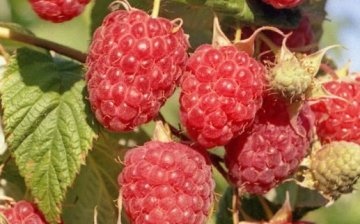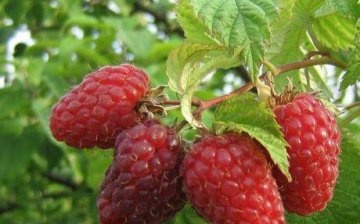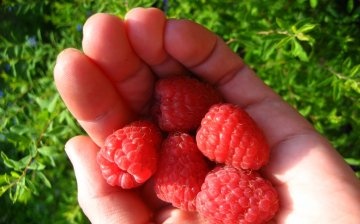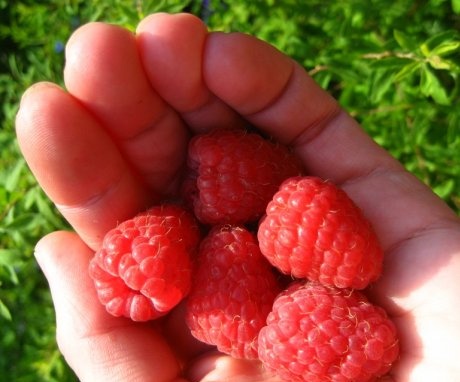Raspberry variety Gusar and its cultivation
Raspberries have long been considered one of the most valuable berry crops. The aromatic and mouth-watering fruits of this plant have nourishing and healing properties. Raspberries have many types, and each species has a large number of varieties. They differ in taste, maturation, disease resistance.
Content:
The most common raspberry varieties are traditional. They are unpretentious, easily adaptable to growing conditions, but do not give a high yield. The raspberry variety Gusar (promising) is very fond of modern gardeners.
Properties of raspberries of the Gusar variety
What attracted gardeners so much to the raspberry variety Gusar? The advantages of this variety are that it is drought-resistant, resistant to disease damage and is not afraid of frost. And also this species belongs to valuable varieties and is high-yielding. With sufficient care from the raspberry bush, you can get up to 3 kg of berries.
The raspberry bush forms little growth, rather spreading and powerful. It grows in height up to 2 meters. Ripe raspberries have a deep ruby color. They are aromatic, sweet and sour and taste good. With normal care, the berries reach a mass of about 4 grams. But if you try and pay more attention to raspberries, you can achieve a mass of berries up to 10 grams.
Raspberry Gusar fruits have an average density, therefore they tolerate transportation well in shallow containers. But the berries are not meant for long-term storage. The harvested crop must be eaten immediately or processed. Delicious jams, preserves and compotes are made from berries. Some housewives freeze raspberries to please their loved ones and friends with delicious fruits in winter.
Raspberry Gusar is medium early. The variety is specially bred for cultivation in regions with hot and dry summers. Therefore, it perfectly adapts to weather conditions and tolerates high temperatures well.
Care and reproduction of raspberries of the Gusar variety
Raspberries of the Gusar variety are unpretentious in growing... For planting raspberries, choose an area with good sunlight. It is desirable that the soil is fertile. The plant should be fed periodically. The best food for raspberries is organic and mineral fertilizers, as well as wood ash.
After the winter "hibernation" carefully examine the raspberry bush and remove the dried branches. During this period, long raspberry branches are not pruned.
The first pruning produced in May, removing excess offspring. The next pruning is in June, when the raspberry bush reaches a height of 1.5 meters. The tops are cut off at a height of 1.0 meters. The third raspberry pruning is done in July. The tops are not touched, but only the side branches are pruned. Such pruning makes it possible to direct the strength of the roots to the development of fruit buds, and not to the growth of numerous shoots and leaves.
In order for the raspberry harvest to please, it is often necessary to loosen the soil near the bush and remove weeds in time.
A good effect is given by this technique: pour a layer of peat mixed with humus around the raspberry bush. Mulching will allow you to retain moisture longer, and the roots of the plant will receive useful nutrients.
Raspberries love abundant watering. In hot weather, when there is no rain for a long time, it is necessary to water the raspberries more often so that they do not dry out. But do not try to overfill.From an excess of moisture, the root system can rot and the plant will die.
Raspberries of the Gusar variety are easy breeds cuttings. Young offspring that do not have their own roots are suitable for this. Cuttings are harvested when they grow up to 3 cm in height and have 3 leaves. The cuttings are tied in small bundles, treated with an organic growth stimulant and placed in a nutrient mixture consisting of peat, earth and humus. The substrate is constantly moisturized. Cuttings begin to take root on the 14-17th day. After 10 days, the cuttings are planted in the ground. It is necessary to ensure that the weather is cloudy at this time. After another two weeks, the cuttings, which are thoroughly strengthened, begin active growth and, by the end of the season, reach half a meter in height.
You can plant raspberries of the Gusar variety with saplings. This is the most common breeding method for raspberries. It is better to buy seedlings in special stores in order to exclude the purchase of low-quality planting material.
Landing seedlings are best carried out in late May - early June. For this, holes of 40x50 cm are prepared in advance, they are filled with planting mixture. Saplings are planted at a sufficient distance from each other. They should not be buried too deep to avoid decay of the basal bud. Seedlings need abundant watering until they are firmly rooted. The soil is mulched with rotted manure, peat, straw or sawdust.
The harvest of horticultural crops, including raspberries, largely depends on the growing conditions and care for them. Adequate care can greatly increase the yield.














Well, I'll go look for the raspberry hussar. you very well described it. For me, 3 kg per bush is fantastic.
This variety has been growing for me for a long time. But there is one subtlety with caring for him. He really is not afraid of short frosts, but an early thaw with an obligatory cold snap can kill Hussar bushes, especially young ones. Hussar bushes need to be covered for the winter.